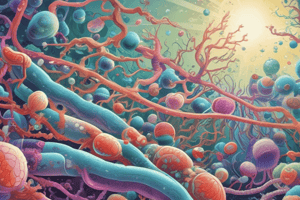Podcast
Questions and Answers
Who is considered the father of scientific method and performed experiments involving 'red meat' and maggots?
Who is considered the father of scientific method and performed experiments involving 'red meat' and maggots?
Which scientist proved that spontaneous generation was not real by heating gravy in a flask and keeping outside particles away?
Which scientist proved that spontaneous generation was not real by heating gravy in a flask and keeping outside particles away?
Who is credited with the discovery of antibiotics after observing the inhibition of staphylococci on plates contaminated with penicillium mold?
Who is credited with the discovery of antibiotics after observing the inhibition of staphylococci on plates contaminated with penicillium mold?
Who developed the concept of 'magic bullets' to destroy pathogens and contributed to the field of chemotherapy?
Who developed the concept of 'magic bullets' to destroy pathogens and contributed to the field of chemotherapy?
Signup and view all the answers
Who is credited with the discovery of streptomycin and coined the term 'antibiotic'?
Who is credited with the discovery of streptomycin and coined the term 'antibiotic'?
Signup and view all the answers
Who developed the concept of asepsis and emphasized the importance of handwashing in preventing infection?
Who developed the concept of asepsis and emphasized the importance of handwashing in preventing infection?
Signup and view all the answers
What is the main characteristic that distinguishes eukaryotes from prokaryotes?
What is the main characteristic that distinguishes eukaryotes from prokaryotes?
Signup and view all the answers
Which type of microorganism is characterized by the presence of hyphae and the ability to reproduce by sexual and asexual spores?
Which type of microorganism is characterized by the presence of hyphae and the ability to reproduce by sexual and asexual spores?
Signup and view all the answers
What is the function of fimbriae in bacteria?
What is the function of fimbriae in bacteria?
Signup and view all the answers
Which type of microorganism is responsible for red tides and shellfish poisoning?
Which type of microorganism is responsible for red tides and shellfish poisoning?
Signup and view all the answers
What is the composition of the cell wall in bacteria?
What is the composition of the cell wall in bacteria?
Signup and view all the answers
What is the function of the glycocalyx in bacteria?
What is the function of the glycocalyx in bacteria?
Signup and view all the answers
Study Notes
Pioneers in Microbiology
- Antoni van Leeuwenhoek: first to observe microorganisms using a microscope
- Robert Koch: developed techniques for cultivating bacteria on solid media
- Carl Woese: discovered that cellular life belongs to three domains: bacteria, eukarya, and archaea
- Ignaz Semmelweis: introduced handwashing to prevent infection
- Joseph Lister: developed antiseptic technique to prevent infection
- John Snow: contributed to infection control and epidemiology
- Edward Jenner: developed vaccines, specifically for smallpox, and founded the field of immunology
- Paul Ehrlich: developed "magic bullets" to destroy pathogens, leading to the field of chemotherapy
- Alexander Fleming: discovered antibiotics, observing the inhibition of staphylococci on plates contaminated with penicillium mold
- Gerhard Domagk: developed prontosil (sulfanilamide) for streptococcal infections
- Selman Waksman: discovered streptomycin and coined the term antibiotic
Conceptual Foundations
Microorganisms
- Fungi: multicellular, eukaryotic, obtain food from other organisms, decomposers, and possess cell walls of chitin
- Molds: multicellular, have hyphae, reproduce by sexual and asexual spores
- Yeasts: unicellular, reproduce asexually by budding, some produce sexual spores
- Protozoa: unicellular, single-celled eukaryotes, similar to animals in nutritional needs and cellular structure
- Algae: unicellular or multicellular, photosynthetic, simple reproductive structures, categorized by pigmentation, storage products, and composition of cell wall
Microorganism Classification
- Prokaryotes (bacteria): unicellular, lack nuclei, smaller than eukaryotes, found everywhere with moisture
- Archaea: cell walls composed of polymers other than peptidoglycan, no diseases
Cell Structure
- Glycocalyces: gelatinous, sticky substance surrounding the outside of the cell, composed of polysaccharides, or rarely polypeptides, or both
- Capsule: composed of organized repeating units of organic chemicals, protects cells from drying out
- Slime layer: loosely attached to cell surface, water-soluble, protects cells from drying out, sticky layer that allows prokaryotes to attach to surfaces
- Flagella: made of tubulin in eukaryotes, allow rotation, composed of rigid protein helices, anchored to the cell wall by the basal body
- Fimbriae: short, numerous, non-motile projections used for adherence, sticky, proteinaceous, bristle-like projections used by bacteria to adhere to one another, hosts, and substances in environment
- Pili: role in conjugation, long hollow tubules composed of pili, longer than fimbriae but shorter than flagella
Studying That Suits You
Use AI to generate personalized quizzes and flashcards to suit your learning preferences.
Description
Learn about the contributions of influential scientists in microbiology and immunology, including Antoni van Leeuwenhoek, Robert Koch, and more. Discover how they impacted our understanding of bacteria, infection control, and disease prevention.




